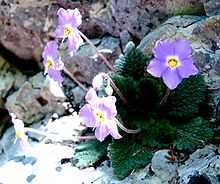Ramonda (plant)
| Ramonda | |
|---|---|
 | |
| Ramonda myconi | |
| Scientific classification | |
| Kingdom: | Plantae |
| (unranked): | Angiosperms |
| (unranked): | Eudicots |
| (unranked): | Asterids |
| Order: | Lamiales |
| Family: | Gesneriaceae |
| Genus: | Ramonda Rich. |
Ramonda is a genus of three species of flowering plants in the family Gesneriaceae, native to shady, rocky places in north eastern Spain, the Pyrenees and south eastern Europe. They are evergreen perennials which form rosettes of crinkly leaves with nearly actinomorphic flowers,[1] borne on leafless stems in spring.[2]
The genus is named after the French botanist and explorer Louis Ramond de Carbonnières, who was among the first to explore the high Pyrenees.[3]
Species
- Ramonda myconi syn. R. pyrenaica
- Ramonda nathaliae
- Ramonda serbica
References
- ↑ G. Theissen & K. Kaufmann (2006). "Molecular developmental genetics and the evolution of flowers". In Brian R. Jordan. The Molecular Biology and Biotechnology of Flowering (2nd ed.). CAB International. pp. 124–149. ISBN 978-1-84593-042-4.
- ↑ RHS A-Z encyclopedia of garden plants. United Kingdom: Dorling Kindersley. 2008. p. 1136. ISBN 1-4053-3296-4.
- ↑ Coombes, Allen J. (2012). The A to Z of plant names. USA: Timber Press. p. 312. ISBN 978-1-60469-196-2.